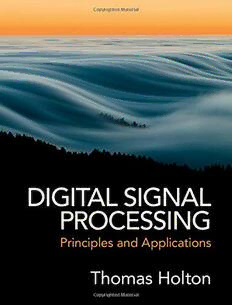Table Of ContentDigital Signal Processing
Principlesand Applications
Combiningclearexplanationsofelementaryprinciples,advancedtopicsandapplicationswith
step-by-step mathematical derivations, this textbook provides a comprehensive yet accessible
introductiontodigitalsignalprocessing.Allthekeytopicsarecovered,includingdiscrete-time
Fourier transform, z-transform, discrete Fourier transform and FFT, A/D conversion, and
FIR and IIR filtering algorithms, as well as more advanced topics such as multirate systems,
the discrete cosine transform and spectral signal processing. Over 600 full-color illustrations,
200 fully worked examples, hundreds of end-of-chapter homework problems and detailed
®
computationalexamplesofDSPalgorithmsimplementedinMatlab andCaidunderstanding
and help put knowledge into practice. A wealth of supplementary material accompanies the
®
bookonline,includinginteractiveprogramsforinstructors,afullsetofsolutionsandMatlab
laboratoryexercises,makingthistheidealtextforseniorundergraduateandgraduatecourses
ondigital signal processing.
Online resources available atwww.cambridge.org/holton
(cid:129) 600+ full-color figures
(cid:129) Interactive programs for instructors
(cid:129) A full set of solutions
(cid:129) Extensive supplementarymaterial, including100+ pages of text and 70+ illustrations
(cid:129) Matlab®laboratory exercises
Thomas Holton is Professor of Electrical and Computer Engineering at San Francisco State
University with interests in speech andaudio processing.
“Professor Holton has done a great service to faculty who teach digital signal processing. The
material is developed in a clear and thorough manner with an excellent range of topics, from
elementarytoadvancedandfromtheoreticaltoapplied.Manyinsightfulanalyticalandcomputa-
tional examples and homework problems are included, with Matlab intelligently integrated. This
textbookistheclearfrontrunnerinacrowdedfield.”
HowardWeinert,JohnsHopkinsUniversity
“...astudent-friendlybook,makinglearningDSPafunjourney.”
ProfessorXiyiHang,CaliforniaStateUniversity–Northridge
“TheDigitalSignalProcessing(DSP)textbookwrittenbyThomasHoltonisanexcellenttextbook
forundergraduateaswellasgraduatestudents.Itiswellwritten,veryclearlydefinedandpresentsall
DSP topics, using many examples including the use of Matlab from chapter 1. In 14 chapters,
Dr. Holton covers all necessary materials for a thorough understanding of DSP concepts and
practicalapplicationsofasubjectwhichisverymathematical.Thereare3appendices,includinga
tutorialonMatlab.Inaddition,thetexthasawebsiteforadditionalreferencematerials.Itiswithout
anyreservationsthatIstronglyendorseandrecommendtheDSPbookbyProfessorHolton.”
MousavinezhadHossein,IdahoStateUniversity
“TheHoltontextincludestechnicalmaterialsthatapracticingengineerneedstoknowtoprototype
a fixed-coefficient DSP system architecture using Matlab. There are many unique features of this
textbook, including a full chapter on visualizing frequency response from pole-zero plots, multi-
colorplotsforbettercomprehension,rigorousderivationofallformulas,andup-to-datehardware-
and software-based implementation ideas for the benefit of novice and practicing engineers.
Istronglyrecommenditsadoption.”
KalyanMondal,FairleighDickinsonUniversity
DIGITAL
SIGNAL
PROCESSING
PRINCIPLES AND APPLICATIONS
Thomas Holton
San Francisco State University
UniversityPrintingHouse,CambridgeCB28BS,UnitedKingdom
OneLibertyPlaza,20thFloor,NewYork,NY10006,USA
477WilliamstownRoad,PortMelbourne,VIC3207,Australia
314–321,3rdFloor,Plot3,SplendorForum,JasolaDistrictCentre,NewDelhi–110025,India
79AnsonRoad,#06–04/06,Singapore079906
CambridgeUniversityPressispartoftheUniversityofCambridge.
ItfurtherstheUniversity’smissionbydisseminatingknowledgeinthepursuitof
education,learning,andresearchatthehighestinternationallevelsofexcellence.
www.cambridge.org
Informationonthistitle:www.cambridge.org/9781108418447
DOI:10.1017/9781108290050
©ThomasHolton2021
Thispublicationisincopyright.Subjecttostatutoryexception
andtotheprovisionsofrelevantcollectivelicensingagreements,
noreproductionofanypartmaytakeplacewithoutthewritten
permissionofCambridgeUniversityPress.
Firstpublished2021
PrintedinSingaporebyMarkonoPrintMediaPteLtd2021
AcatalogrecordforthispublicationisavailablefromtheBritishLibrary.
ISBN978-1-108-41844-7Hardback
Additionalresourcesforthispublicationatwww.cambridge.org/holton.
CambridgeUniversityPresshasnoresponsibilityforthepersistenceoraccuracy
ofURLsforexternalorthird-partyinternetwebsitesreferredtointhispublication
anddoesnotguaranteethatanycontentonsuchwebsitesis,orwillremain,
accurateorappropriate.
To my parents, Gerald and Nina Holton.
CONTENTS
Preface xxi
1 Discrete-time signals and systems 1
Introduction 1
1.1 Two signal processing paradigms 1
1.2 Advantages of digitalsignal processing 3
1.3 Applications of DSP 5
1.4 Signals 6
1.4.1 Signal classification 7
1.4.2 Discrete-time signals 8
1.5 Basic operations onsignals 10
1.5.1 Shift 10
1.5.2 Flip 11
1.5.3 Flip and shift 12
1.5.4 Time decimation 13
1.5.5 Time expansion 14
1.5.6 Operation onmultiple sequences 14
1.6 Basic sequences 15
1.6.1 Impulse 15
1.6.2 Unit step 19
1.6.3 Pulse 21
1.6.4 Power-law sequences 22
1.6.5 Sinusoidalsequences 22
1.6.6 Complexexponential sequences 26
1.6.7 Sequence classification 28
1.7 Systems 32
1.7.1 Discrete-time scalar multiplier 32
1.7.2 Offset 34
1.7.3 Squarer 34
1.7.4 Shift 35
1.7.5 Moving-window average 36
1.7.6 Summer 37
1.7.7 Switch 38
1.7.8 Linear constant-coefficient difference equation (LCCDE) 38
1.8 Linearity 39
1.8.1 The additivity property 39
1.8.2 The scaling property 40
1.8.3 Discrete-time scalar multiplier 41
1.8.4 Offset 41
1.8.5 Squarer 42
1.8.6 Shift 42
1.8.7 Moving-window average 43
1.8.8 Summer 43
1.8.9 Switch 44
viii Contents
1.8.10 Linear constant-coefficient difference equation 44
1.8.11 The “zero-in, zero-out” propertyof linear systems 46
1.9 Time invariance 46
1.9.1 Discrete-time scalar multiplier 47
1.9.2 Offset 47
1.9.3 Squarer 47
1.9.4 Shift 47
1.9.5 Moving-window average 47
1.9.6 Summer 48
1.9.7 Switch 48
1.9.8 Linear constant-coefficient difference equation (LCCDE) 49
1.10 Causality 49
1.10.1 Discrete-time scalar multiplier 50
1.10.2 Offset 50
1.10.3 Squarer 50
1.10.4 Shift 50
1.10.5 Moving-window average 50
1.10.6 Summer 50
1.10.7 Switch 51
1.10.8 Linear constant-coefficient difference equation (LCCDE) 51
1.11 Stability 51
1.11.1 Discrete-time scalar multiplier 51
1.11.2 Offset 51
1.11.3 Squarer 51
1.11.4 Shift 52
1.11.5 Moving-window average 52
1.11.6 Summer 52
1.11.7 Switch 52
1.11.8 Linear constant-coefficient difference equation (LCCDE) 52
Summary 52
Problems 53
2 Impulse response 63
Introduction 63
2.1 FIR and IIR systems 63
2.1.1 Finite impulseresponse (FIR) systems 63
2.1.2 Infinite impulse response (IIR) systems 65
2.1.3 Responseof a system toa flipped and shifted impulse 66
2.2 Convolution 68
2.2.1 Direct-summation method 69
2.2.2 Flip-and-shift method 71
2.2.3 Convolutionexamples 72
2.3 Properties of convolution 78
2.3.1 The commutative property 78
2.3.2 The associative property 81
2.3.3 The distributive property 82

